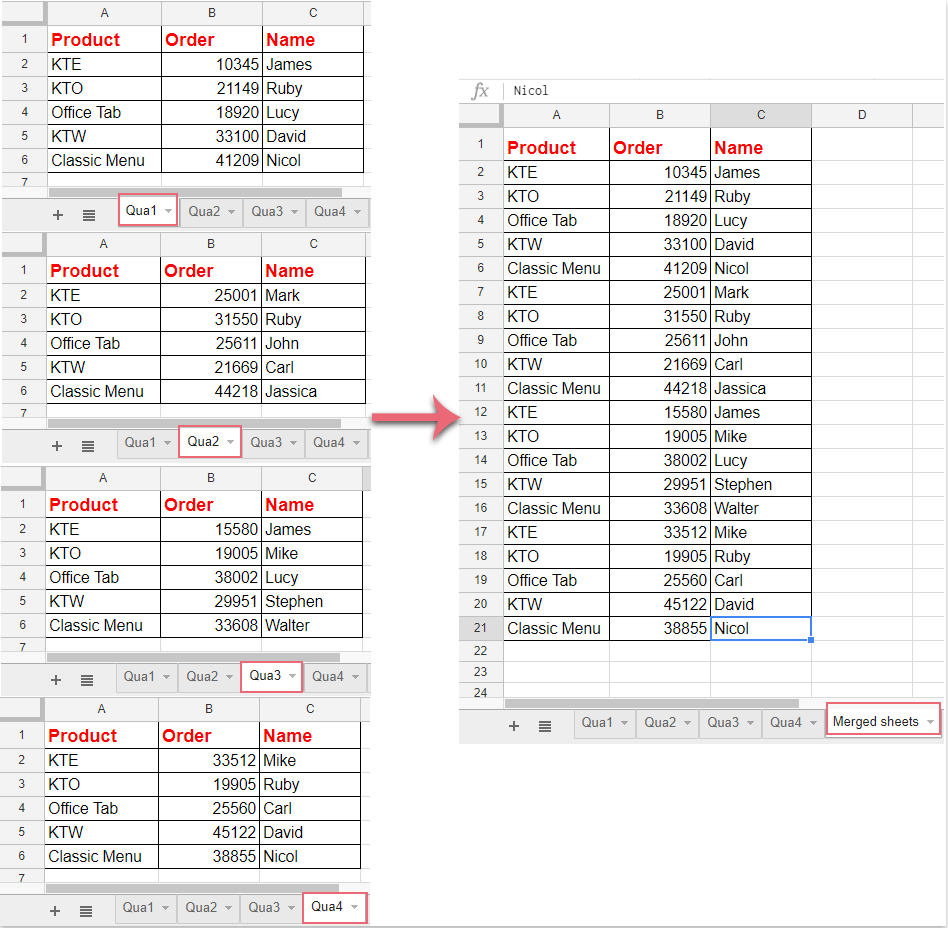5 Easy Ways to Combine Excel Sheets into One

In today's data-driven world, managing and analyzing data across multiple Excel spreadsheets can often become a cumbersome task. Whether you're compiling monthly reports, tracking project progress, or consolidating survey responses, merging these sheets into one single workbook can streamline your workflow, reduce errors, and enhance efficiency. In this post, we'll explore five straightforward methods to combine Excel sheets, ensuring you can integrate data smoothly and effectively.
Method 1: Manual Copy and Paste

While this might seem like the most basic approach, for small datasets or one-time consolidations, manually copying and pasting data is both quick and simple:
- Open both the source and destination Excel files.
- Copy the data from the source sheet by selecting the range, right-clicking, and choosing ‘Copy’.
- Switch to the destination file, select the cell where you want to start pasting, right-click, and choose ‘Paste’.
📝 Note: This method can become impractical for large datasets or frequent updates due to the potential for errors in data transfer or formatting issues.
Method 2: Use Power Query


Power Query is a powerful tool within Excel that simplifies the task of combining data from multiple sheets:
- Go to the ‘Data’ tab in Excel, and click ‘Get Data’ > ‘From File’ > ‘From Workbook’.
- Select the workbook containing the sheets you want to combine.
- In the Navigator pane, you can select multiple worksheets by holding down the CTRL key. Click ‘Transform Data’.
- Use Power Query’s ‘Merge’ or ‘Append’ functions to combine the data as needed. After transformation, click ‘Close & Load’ to bring the data into your Excel worksheet.
Power Query not only consolidates data but also allows for data cleansing and transformation, making it a versatile tool for data management.
Method 3: Excel Macros (VBA)

If you often need to combine data from multiple sheets, using VBA macros can save time and reduce manual effort:
- Open the Visual Basic Editor by pressing ALT + F11 or navigating through ‘Developer’ tab > ‘Visual Basic’.
- Create a new module and insert the following VBA code to combine sheets:
Sub CombineSheets()
Dim ws As Worksheet
Dim destWs As Worksheet
Dim lastRow As Long
Dim lastColumn As Long
' Open the workbook you want to consolidate into
Set destWs = Workbooks.Open("C:\YourPath\YourDestinationWorkbook.xlsx").Worksheets(1)
' Loop through each worksheet in the source workbook
For Each ws In ThisWorkbook.Worksheets
If ws.Name <> destWs.Name Then
' Find the last used row and column
lastRow = ws.Cells(ws.Rows.Count, 1).End(xlUp).Row
lastColumn = ws.Cells(1, ws.Columns.Count).End(xlToLeft).Column
' Copy data from source to destination
ws.Range(ws.Cells(1, 1), ws.Cells(lastRow, lastColumn)).Copy Destination:=destWs.Cells(destWs.Rows.Count, 1).End(xlUp).Offset(1, 0)
End If
Next ws
MsgBox "Data has been combined successfully!"
End Sub
</code></pre>
<li>Run the macro by selecting it in the VBA editor and pressing <kbd>F5</kbd>, or by assigning it to a button in Excel.</li>
🛠️ Note: Before running the macro, ensure you save your work, as macros can overwrite data if not used correctly.
Method 4: Using Third-Party Tools

If Excel’s built-in features aren’t sufficient for your needs, several third-party tools exist that can help:
- Consolidate Excel Add-In: This add-in lets you combine worksheets from multiple workbooks with just a few clicks.
- Merge Spreadsheets Tool: Various online services allow you to upload and merge Excel files directly from your browser.
While these tools can be user-friendly, consider the security of your data when using online platforms and the potential for formatting issues when using add-ins.
Method 5: Using Excel’s Consolidate Feature

Excel’s ‘Consolidate’ function is designed for summarizing and combining data from multiple ranges:
Step
Description
1
Open the workbook where you want to consolidate data.
2
Select the destination cell where you want the data to appear.
3
Navigate to the ‘Data’ tab, click ‘Consolidate’.
4
In the Consolidate window, choose ‘Function’ (Sum, Average, etc.), then add ranges from different sheets or workbooks by clicking ‘Add’.
5
Click ‘OK’ to combine the data.

This method is particularly useful for summarizing data, but it doesn’t copy over formatting or formulas.
In summary, combining Excel sheets can be accomplished through various methods, each suited for different scenarios:
- Manual copy and paste for one-time or small datasets.
- Power Query for complex data manipulation.
- VBA macros for automation and repeated tasks.
- Third-party tools for ease of use and additional features.
- Excel's Consolidate for summary data from multiple sources.
Choosing the right method depends on your specific needs, the size of your data, and how often you need to perform this task. With these tools at your disposal, you're now equipped to manage your Excel sheets more efficiently, saving time and reducing the likelihood of errors in data consolidation.
Can I combine sheets from different Excel files?

+
Yes, you can combine sheets from different Excel files using methods like Power Query, VBA macros, or third-party tools.
What happens if the sheets I’m combining have different structures?

+
When combining sheets with different structures, you might need to manually adjust the data to fit into a uniform structure, or use tools like Power Query to transform the data before merging.
Is there any risk of data loss when combining sheets?

+
Yes, there is always a risk of data loss, especially with manual methods or if macros aren’t written correctly. Always back up your data before making significant changes.



